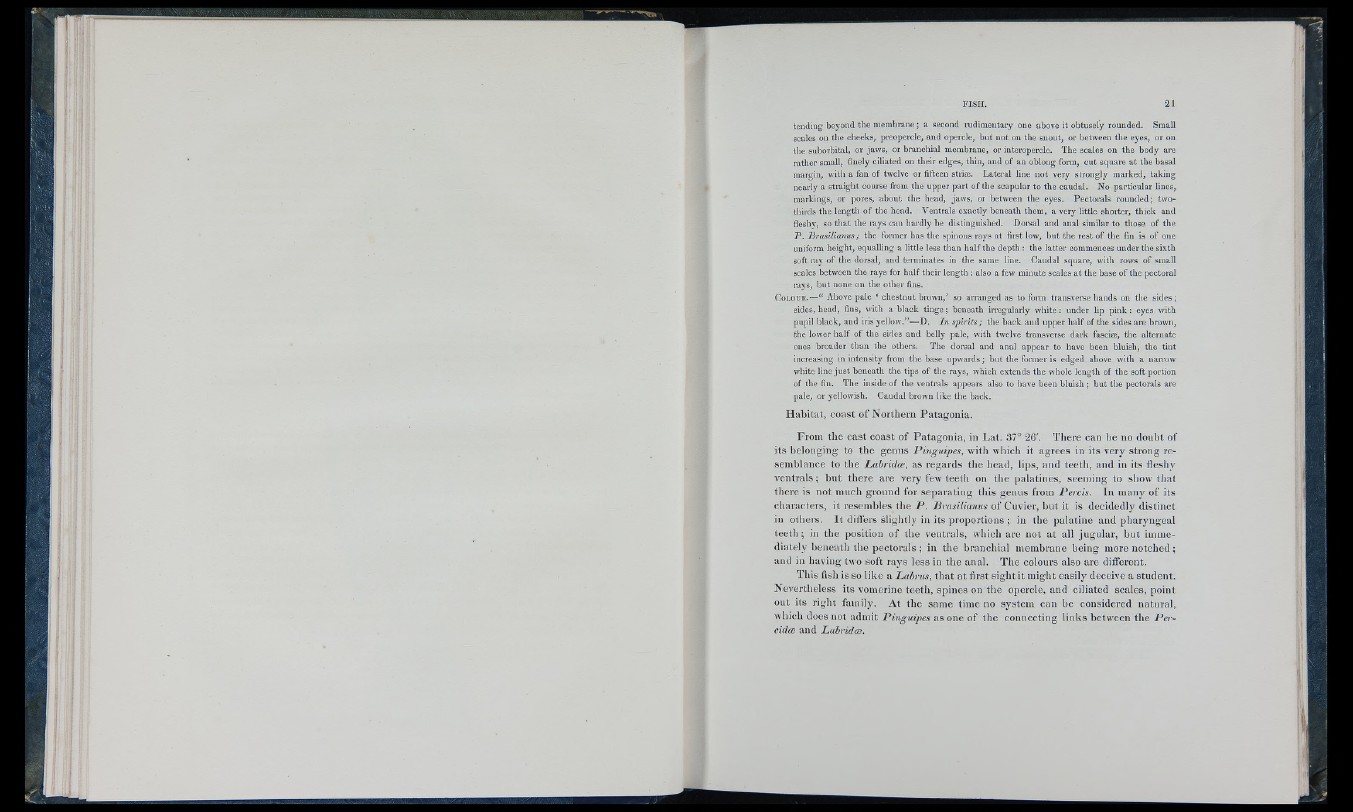
FISH . 21
tending beyond the m em brane; a second rudimentary one above it obtusely rounded. Small
scales on the cheeks, preopercle, and opercle, hut not on the snout, or between the eyes, or on
the suborbital, or jaw s, or branchial membrane, or interoperele. The scales on the body are
rather small, finely ciliated on their edges, thin, and of an oblong form, cut square at the basal
margin, with a fan of twelve or fifteen stri®. Lateral line not very strongly m arked, taking
nearly a straight course from the upper part of the scapular to the caudal. No particular lines,
markings, or pores, about the head, jaw s, or between the eyes. Pectorals rounded; two-
thirds the length of the head. Ventrals exactly beneath them, a very little shorter, thick and
fleshy, so that the rays can hardly be distinguished. Dorsal and anal similar to those of the
P . B rasilian us; the former has the spinous rays at first low, but the rest of the fin is of one
uniform height, equalling a little less than h alf the depth : the latter commences under the sixth
soft ray of the dorsal, and terminates in the same line. C audal square, with rows of small
scales between the rays for half their length : also a few minute scales at the base of the pectoral
rays, but none on the other fins.
C o l o u r .— “ Above pale ‘ chestnut brown,’ so arranged as to form transverse bands on the sides ;
sides, head, fins, with a black tinge; beneath irregularly w hite: under lip p in k : eyes with
pupil black, and iris yellow.”— D. In spirits; the back and upper h alf of the sides are brown,
the lower h alf of the sides and belly pale, with twelve transverse dark fasci®, the alternate
ones broader than the others. The dorsal and anal appear to have been bluish, the tint
increasing in intensity from the base upw ards; but the former is edged above with a narrow
white line ju st beneath the tips of the rays, which extends the whole length of the soft portion
of the fin. The inside of the ventrals appears also to have been bluish ; but the pectorals are
pale, or yellowish. Caudal brown like the back.
H abitat, coast of Northern Patagonia.
From the east coast of Patagonia, in Lat. 37° 26'. There can be no doubt of
its belonging to the genus Pinguipes, with which it agrees in its very strong resemblance
to the Labridce, as regards the head, lips, and teeth, and in its fleshy
ventrals; but there are very few teeth on the palatines, seeming to show that
there is not much ground for separating this genus from Percis. In many of its
characters, it resembles the P . B i asilianus of Cuvier, but it is decidedly distinct
in others. It differs slightly in its proportions ; in the palatine and pharyngeal
teeth ; in the position of the ventrals, whicli are not at all jugular, but immediately
beneatli the pectorals; ill the branchial membrane being more notched;
and in having two soft rays less in the anal. Tlie colours also are different.
This fish is so like w Lahrus, that at first sight it m ight easily deceive a student.
Nevertheless its vomerine teeth, spines on the opercle, and ciliated scales, point
out its right family. At the same time no system can be considered natural,
which does not admit Pinguipes as one of the connecting links between the Per-
cidce and Labridce.